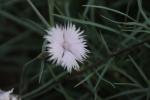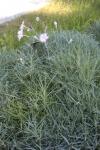Unsere Facebook-Gruppe: Heilpflanzen als Medizin
Feder-Nelke - Dianthus plumarius L.
Englisch: Bellflowers, Clove pink, Common Pink, Cottage pink, Feathered pink, Garden Pink, Grass-pink, Grass pink, Laced pink, Pheasantseye, Pheasant’s-eye, Pink, Single Cottage Pink, Single pink, Wild pink

Bild © (1)
Synonyme dt.:
Feder-N.
Feder-Nelke
Federnelke
Hainburger Nelke
Synonyme :
Caryophyllus plumarius (L.) Moench
Cylichnanthus plumarius (L.) Dulac
Dianthus blandus (Rchb.) Hayek
Dianthus blandus Rchb.
Dianthus dubius Hornem.
Dianthus dubius Hornem. ex DC.
Dianthus hoppei Port.
Dianthus hoppei Port. ex Hayek
Dianthus hoppei subsp. blandus (Rchb.) Neumayer
Dianthus hortensis Schrad.
Dianthus hortensis Schrad. ex Willd.
Dianthus hungaricus Pers.
Dianthus hungaricus subsp. regis-stephani (Rapaics) Holub
Dianthus moschatus Hort.Par.
Dianthus moschatus Hort.Par. ex Ser.
Dianthus neilreichii Hayek
Dianthus odoratus Vest
Dianthus odoratus Vest ex Steud.
Dianthus plumarius f. hortensis
Dianthus plumarius f. palaviensis Novák
Dianthus plumarius f. pseudopraecox Novák
Dianthus plumarius subsp. blandus (Rchb.) Hegi
Dianthus plumarius subsp. hoppei (Port.) Hegi
Dianthus plumarius subsp. neilreichii (Hayek) Hegi
Dianthus plumarius subsp. praecox (Willd. ex Spreng.) Domin
Dianthus plumarius subsp. regis-stephani (Rapaics) Baksay
Dianthus plumarius subsp. regis-stephani (Rapaics) Boksay
Dianthus plumarius var. blandus Rchb.
Dianthus plumarius var. hortensis (Schrad. ex Willd.) Ser.
Dianthus plumarius var. portensis Ser.
Dianthus plumarius var. semperflorens
Dianthus plumarius var. serotinus W.D.J.Koch
Dianthus portensis Libosch.
Dianthus portensis Libosch. ex Ser.
Dianthus praecox Kit. ex Schult.
Dianthus praecox Willd.
Dianthus praecox Willd. ex Spreng.
Dianthus praecox subsp. neilreichii (Hayek) Kmet'ová
Dianthus regis-stephani Rapaics
Dianthus winteri J.L.Gibson
Silene plumaria (L.) E.H.L.Krause
Tunica plumaria (L.) Scop.
Stengel bzw. Stamm: Vielköpfige, rasenbildende Pflanze. Stengel und Blätter blauduftig. Meist einblütig. Grösse 15 bis 30 cm.
Blüte: Blumenkronenblätter vom tief fingerförmig oder fiederspaltig eingeschnitten. Blumenkronenblätter tief fingerförmig eingeschnitten; das ungeteilte Mittelfeld ist umgekehrt-eiförmig. Die Kelchschuppen sind kurz und einschliesslich ihrer Stachelspitze ein Viertel so lang wie der Kelch. Blumen - kröne rosenrot oder weiss, oft am Schlünde gefleckt und meist bärtig. Blütezelt Juni, Juli.
Vorkommen: Europa, nun weit verbreitet
An Felsenabhängen in Steiennark, Niederösterreich, Mähren. Beliebte Gartenpflanze.
Weitere Informationen, Nutzen: (Wichtiger Hinweis!)
Zierpflanze
Genussmittel, Nahrungsmittel:
Blüte: essbare Dekoration, in Salat, kandiert als Süßspeise
Medizinisch:
Die Blütenwerden bei Herzschmerzen, Nervenproblemen, Leberbeschwerden, Augenreizungen, grauen Star verwendet.
Speisewert:
Medizinisch
2 Bild(er) für diese Pflanze
Dianthus plumarius © Frank Lohrmann |
Dianthus plumarius © Frank Lohrmann |
Abmessungen:
Pflanze Höhe : 15.00 ... 30.00 cm xFrucht Größe:
Samen Größe:
Wuchsform
 Krautige Pflanzen, Halbsträucher
Krautige Pflanzen, Halbsträucher  Stacheln an Stamm oder Blatt
Stacheln an Stamm oder Blatt Blütezeit
 Blütezeit Juni - 06
Blütezeit Juni - 06 Blütezeit Juli - 07
Blütezeit Juli - 07 Pflanze Jährigkeit
 Mehrjährig
MehrjährigHaare
 Haare drüsig, warzig
Haare drüsig, warzig  Haare Sternzellig, auch 2-armig, verzweigt oder federig
Haare Sternzellig, auch 2-armig, verzweigt oder federig  Haare verzweigt
Haare verzweigt Blätter
 Blätter gegenständig oder wirtelig (quirlig)
Blätter gegenständig oder wirtelig (quirlig)  Blätter wechselständig (exkl. Zweizeilig bei Einkeimblättriten)
Blätter wechselständig (exkl. Zweizeilig bei Einkeimblättriten)  Blätter einfach, ungeteilt
Blätter einfach, ungeteilt  Geadert, gefiedert oder kaum sichtbar in Blätter oder Teile geteilt
Geadert, gefiedert oder kaum sichtbar in Blätter oder Teile geteilt  Aderung in Längsblätter oder Teile (inkl. 3-teilige Blätter)
Aderung in Längsblätter oder Teile (inkl. 3-teilige Blätter)  Blattränder ohne Lappen, Zähne, Teile
Blattränder ohne Lappen, Zähne, Teile  Bltter oder Blatteile gezahnt, gesägt, gekerbt, usw.
Bltter oder Blatteile gezahnt, gesägt, gekerbt, usw.  Epidermid des Blattes papillös (nur Zweikeimblättrige)
Epidermid des Blattes papillös (nur Zweikeimblättrige)  Nebenblätter fehlen
Nebenblätter fehlen  Nebenblätter vorhanden (auch, wenn nur noch Narben zu sehen sind)
Nebenblätter vorhanden (auch, wenn nur noch Narben zu sehen sind) Blütenstand
 Blüte einzeln
Blüte einzeln  Blütenstand einfach und sympodial (Zyme, Wickel, Verzweigt)
Blütenstand einfach und sympodial (Zyme, Wickel, Verzweigt)  Blütenstand verbunden, sympodial oder monopodial (Rispe, Thyrsos etc.)
Blütenstand verbunden, sympodial oder monopodial (Rispe, Thyrsos etc.) Blüten
 bisexuell
bisexuell  unisexual
unisexual  actinomorph bzw. Sternförmig, Radialsymetrisch, Radförmig usw.
actinomorph bzw. Sternförmig, Radialsymetrisch, Radförmig usw.  Blütenboden klein, (oberständiger Fruchtknoten)
Blütenboden klein, (oberständiger Fruchtknoten)  Blütenboden vergrössert, konisch oder kalbkugelförmig (oberständiger Fruchtknoten)
Blütenboden vergrössert, konisch oder kalbkugelförmig (oberständiger Fruchtknoten)  Staubgefässe vorhanden (Ringförmig oder Drüsen)
Staubgefässe vorhanden (Ringförmig oder Drüsen)  Keine Staubgefässe
Keine Staubgefässe  Blütenhülle (Perianth) Segmente: 4
Blütenhülle (Perianth) Segmente: 4  Blütenhülle (Perianth) Segmente: 5
Blütenhülle (Perianth) Segmente: 5  Blütenhülle (Perianth) Segmente:> 6
Blütenhülle (Perianth) Segmente:> 6  Blütenhülle besteht aus ähnlichen Segmenten
Blütenhülle besteht aus ähnlichen Segmenten  Blütenhülle von Kelch und Krone
Blütenhülle von Kelch und Krone  Kelchblätter 4
Kelchblätter 4  Kelchblätter 5
Kelchblätter 5  Kelchblätter untereinander frei
Kelchblätter untereinander frei  Kelchblätter verwachsen (mindestens 2)
Kelchblätter verwachsen (mindestens 2)  Kelchblätter schuppig oder verzerrt
Kelchblätter schuppig oder verzerrt  Blütenblätter 0 (inkl. Einem becherartigen Blütenkrone ohne Blätter)
Blütenblätter 0 (inkl. Einem becherartigen Blütenkrone ohne Blätter)  Blütenblätter 4
Blütenblätter 4  Blütenblätter 5
Blütenblätter 5  Blütenblätter alle frei voneinander
Blütenblätter alle frei voneinander  Blütenblätter schuppig
Blütenblätter schuppig  Corona vorhanden oder im Grunde Schuppig
Corona vorhanden oder im Grunde Schuppig  Staubbeutel 1, fruchtbar
Staubbeutel 1, fruchtbar  Staubbeutel 2, fruchtbar
Staubbeutel 2, fruchtbar  Staubbeutel 3, fruchtbar
Staubbeutel 3, fruchtbar  Staubbeutel 4, fruchtbar
Staubbeutel 4, fruchtbar  Staubbeutel 5, fruchtbar
Staubbeutel 5, fruchtbar  Staubbeutel 8, fruchtbar
Staubbeutel 8, fruchtbar  Staubbeutel 10, fruchtbar
Staubbeutel 10, fruchtbar  Blüte obidiplostemonous, doppelt so viel Staubblätter als Blütenblätter
Blüte obidiplostemonous, doppelt so viel Staubblätter als Blütenblätter  Staubbeutel dorsal oder herzförmig fixiert
Staubbeutel dorsal oder herzförmig fixiert  Staubbeutel an der Basis fixiert
Staubbeutel an der Basis fixiert  Staubbeutel nach Innen gerichtet
Staubbeutel nach Innen gerichtet  Staubbeutel länsschlitzig öffnend
Staubbeutel länsschlitzig öffnend  Staubblätter frei von Krone
Staubblätter frei von Krone  Staubfäden nicht verwachsen
Staubfäden nicht verwachsen  Staubfäden verwachsen - EIn Rohr oder ein Bündel
Staubfäden verwachsen - EIn Rohr oder ein Bündel  Sterile Staubblätter vorhanden (nur bei männlichen oder pferfekten Blüten)
Sterile Staubblätter vorhanden (nur bei männlichen oder pferfekten Blüten)  Mehr als 1 Stiel, frei (Fruchtblätter verwachsen)
Mehr als 1 Stiel, frei (Fruchtblätter verwachsen)  Stiel 1, oder: Stiele mehr oder weniger verwachsen (Fruchtblätter frei oder verwachsen)
Stiel 1, oder: Stiele mehr oder weniger verwachsen (Fruchtblätter frei oder verwachsen)  Fruchtblätter 2 (frei oder vereinigt)
Fruchtblätter 2 (frei oder vereinigt)  Fruchtblätter 3 (frei oder vereinigt)
Fruchtblätter 3 (frei oder vereinigt)  Fruchtblätter 4 (frei oder vereinigt)
Fruchtblätter 4 (frei oder vereinigt)  Fruchtblätter 5 (frei oder vereinigt)
Fruchtblätter 5 (frei oder vereinigt)  Fruchknoten 1-kammerig
Fruchknoten 1-kammerig  1 Samen pro Fruchtkammer
1 Samen pro Fruchtkammer  2 Samen pro Fruchtkammer
2 Samen pro Fruchtkammer  Mehr als 2 Samen pro Fruchtkammer
Mehr als 2 Samen pro Fruchtkammer  Samenanlagen zentral, Fruchtblätter verwachsen
Samenanlagen zentral, Fruchtblätter verwachsen  Samenanlagen mittig befestigt, oder bauchseits, wenn Fruchtblätter frei oder 1 Fruchtblatt
Samenanlagen mittig befestigt, oder bauchseits, wenn Fruchtblätter frei oder 1 Fruchtblatt  Samenanlagen an der Basis des Fruchtknotens befestigt
Samenanlagen an der Basis des Fruchtknotens befestigt Früchte
 Frucht ist eine Kapsel (inkl. Hülse, Schote, Balgen)
Frucht ist eine Kapsel (inkl. Hülse, Schote, Balgen)  Frucht ist eine Nuss (inkl. Schließfrucht, Spaltfrucht usw.)
Frucht ist eine Nuss (inkl. Schließfrucht, Spaltfrucht usw.)  Frucht ist fleischig (Beeren, Steinfrüchte, Kernobst)
Frucht ist fleischig (Beeren, Steinfrüchte, Kernobst)  Frucht hat 1 Samen
Frucht hat 1 Samen  Frucht hat 2 Samen
Frucht hat 2 Samen  Frucht hat mehr als 2 Samen
Frucht hat mehr als 2 Samen  Samen mit Flügeln
Samen mit Flügeln  Samen mit Haaren
Samen mit Haaren  Samenmantel oder mantelähnliche Organe vorhanden
Samenmantel oder mantelähnliche Organe vorhanden  Keim gerade
Keim gerade  Keim gekrümmt
Keim gekrümmt  Samen ohne Nährgewebe
Samen ohne Nährgewebe Verbreitung
 Asien
Asien  Europa
Europa  Nordamerika
Nordamerika  Previous
Previous


